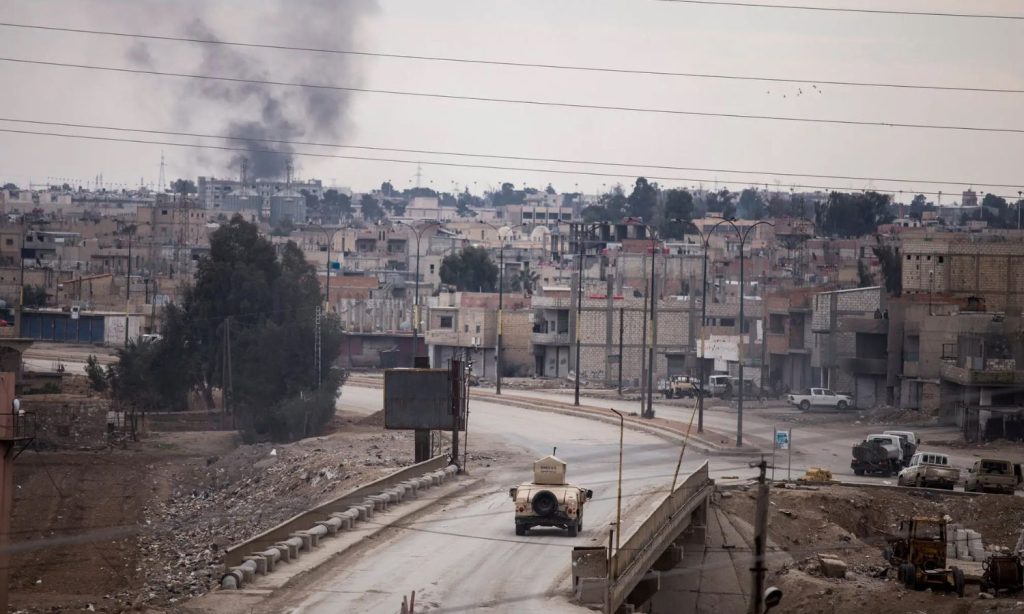Al-Hasakah – Majd al-Salem
The residents of the Ghweran neighborhood in the northeastern al-Hasakah governorate have been suffering from continuous security restrictions since the Islamic State (IS) group’s attack in late January 2022 on the Ghweran prison that contains thousands of IS militants.
The southern neighborhood of al-Hasakah is surrounded by the Khabour River, which almost isolates it from the entire city, which made it easy for the US-backed Syrian Democratic Forces (SDF) to control entry and exit movements through two main bridges linking the neighborhood to the city center and its main market, and the two bridges are rarely open to transit traffic in the same time.
Geographically isolated
Most of the time, the SDF closes one of the bridges in order to devote itself to inspecting the pedestrians from the second bridge and opens the other bridge to close the first, in turns.
According to local residents interviewed by Enab Baladi, hundreds of university students and various educational levels leave the neighborhood every day, as well as other civilians who visit government departments and others who go to the city’s central markets, while security barriers and inspection campaigns that have been going on for a year impede their daily lives.
Etab, 35, a resident of the Ghweran neighborhood, told Enab Baladi that the SDF forces them “often” to turn back from one bridge and take the other bridge, with the two bridges separated by about one kilometer.
The matter becomes even more difficult if the residents move on foot with children or belongings.
In addition, movement during the winter season made it more difficult for them to move to and from the neighborhood, as most of the roads are bad and full of potholes that are flooded with water and mud after it rains.
In recent days, the weather has increased the ruggedness of the roads, as the situation has become “catastrophic,” especially for children and the elderly. Also, part of these roads have turned completely dirt after the asphalt layer “disappeared” from them, according to Etab.
No transportation
Residents of Ghweran neighborhood also suffer from internal transportation, as it is almost absent from the neighborhood, as a limited number of mini buses are available during specific times and dates.
Although taxi services are also available to a limited extent in the neighborhood, residents are not inclined to use them due to their high cost.
Taxi drivers take advantage of the remoteness of the neighborhood and the surrounding security conditions in which it lives to raise the fare to about 7,000 SYP, and it may reach 10,000 SYP during the evening time.
Motorcycles are banned
Residents of the Ghweran neighborhood depend on motorcycles as a primary means of transportation, in addition to being a source of income for hundreds of families from the neighborhood.
From time to time, the SDF prevents these motorcycles from roaming inside al-Hasakah city due to what it describes as “security” reasons, which hinders the movement and work of residents, while motorcycles have been banned in the Ghweran neighborhood since the IS attack on the neighborhood in early 2022, and restrictions are still imposed on its use to this day.
Muhannad, 39, works as a passenger transporter on his motorcycle for a fixed fee of about 2000 SYP.
He told Enab Baladi that he lost his basic job after the SDF decided to ban the use of motorcycles in the Ghweran neighborhood.
Muhannad turned into a porter, moving between food warehouses and the central al-Hal market, working from morning until evening for ten thousand Syrian pounds a day to support his family, including his three children, while he earned twice that amount from his work in transporting passengers by motorcycle.
Despite the continuous protests by motorcycle owners, and the demand to lift the ban on their use for several months, the SDF has not yet responded to these demands under the pretext of “security necessities.”
Ghweran prison, IS attack
January 19th marks the anniversary of the events in Ghweran prison, when IS militants attacked the prison, seeking to release their fellows who were arrested by the SDF and the US-led International Coalition forces (ICF).
During the surprise attack, IS sleeper cells were able to enter the prison, kill its guards, and barricade themselves inside with the prisoners.
The battles continued between the IS and the SDF, backed by the International Coalition, for about a month.
The battles left hundreds of deaths and injuries, according to statistics issued by IS and the SDF, while unknown numbers of IS members and commanders escaped from the prison.
Days after the end of the battles, the SDF raided the civilians’ homes in the neighborhood, searching for the fleeing prisoners.
It also blew up houses it said belonged to people who participated in the attack on the side of the Islamic State group.

